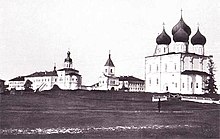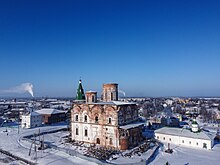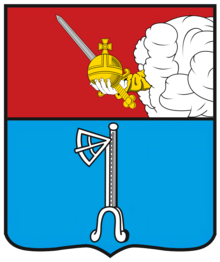You can help expand this article with text translated from the corresponding article in Russian. (January 2022) Click [show] for important translation instructions.
|




Kholmogory (Russian: Холмого́ры) is a historic rural locality (a selo) and the administrative center of Kholmogorsky District of Arkhangelsk Oblast, Russia. It lies on the left bank of the Northern Dvina, along the Kholmogory Highway, 75 kilometers (47 mi) southeast of Arkhangelsk and 90 kilometers (56 mi) north of the Antonievo-Siysky Monastery. The name is derived from the Finnish Kalmomäki for "corpse hill" ("cemetery"). Population: 4,150 (2010 Census);[1] 4,592 (2002 Census);[2] 5,205 (1989 Soviet census).[3]
The Kholmogory area was at first in historical times inhabited by the Finno-Ugrians "Zavolochskaya Chud", (i.e. "the Chud [who live] beyond the portage"), known also as Yems in old Novgorod chronicles, and Karelians. The first Slavonic population to enter Kalmamäki were Pomors from Vologda area after 1220. As early as the 14th century, the village (the name of which was then spelled Kolmogory) was an important trading post of the Novgorod Republic in the Far North of Russia. Its commercial importance further increased in 1554 when the English Muscovy Company made it a center of its operations in furs. The Polish-Lithuanian irregular forces known as Lisowczycy besieged the wooden fort during the Time of Troubles (1613), but had to retreat in failure.
- ^ Russian Federal State Statistics Service (2011). Всероссийская перепись населения 2010 года. Том 1 [2010 All-Russian Population Census, vol. 1]. Всероссийская перепись населения 2010 года [2010 All-Russia Population Census] (in Russian). Federal State Statistics Service.
- ^ Federal State Statistics Service (May 21, 2004). Численность населения России, субъектов Российской Федерации в составе федеральных округов, районов, городских поселений, сельских населённых пунктов – районных центров и сельских населённых пунктов с населением 3 тысячи и более человек [Population of Russia, Its Federal Districts, Federal Subjects, Districts, Urban Localities, Rural Localities—Administrative Centers, and Rural Localities with Population of Over 3,000] (XLS). Всероссийская перепись населения 2002 года [All-Russia Population Census of 2002] (in Russian).
- ^ Всесоюзная перепись населения 1989 г. Численность наличного населения союзных и автономных республик, автономных областей и округов, краёв, областей, районов, городских поселений и сёл-райцентров [All Union Population Census of 1989: Present Population of Union and Autonomous Republics, Autonomous Oblasts and Okrugs, Krais, Oblasts, Districts, Urban Settlements, and Villages Serving as District Administrative Centers]. Всесоюзная перепись населения 1989 года [All-Union Population Census of 1989] (in Russian). Институт демографии Национального исследовательского университета: Высшая школа экономики [Institute of Demography at the National Research University: Higher School of Economics]. 1989 – via Demoscope Weekly.